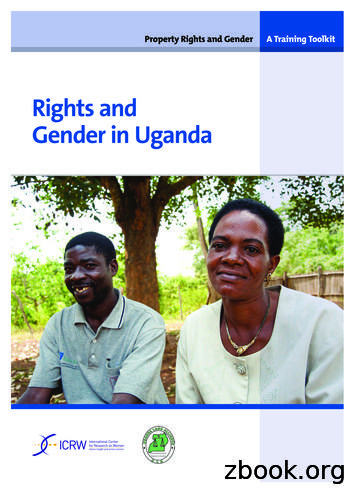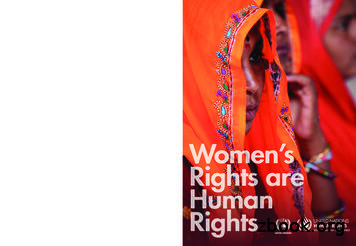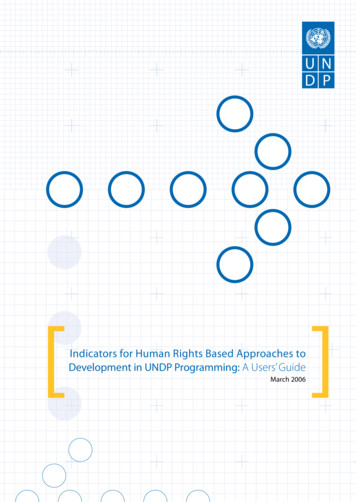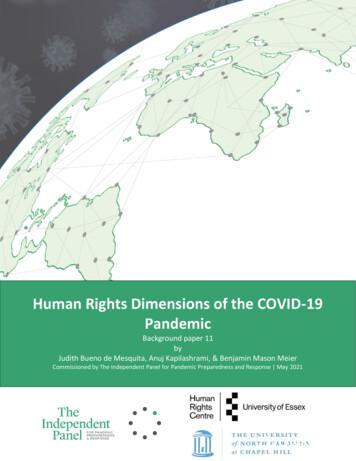International Human Rights Law And Abortion In Latin
Human Rights and AbortionJuly 2005International Human Rights Lawand Abortion in Latin AmericaLatin America is home to some of the most restrictive abortion laws in the world. While onlythree countries—Chile, El Salvador, and the Dominican Republic—provide no exceptions orextenuating circumstances for the criminal sanctions on abortion, in most countries andjurisdictions, exceptions are provided only when necessary to save the pregnant woman’s lifeand in certain other narrowly defined circumstances. Even where abortion is not punished bylaw, women often have severely limited access because of lack of proper regulation andpolitical will.Advancing access to safe and legal abortion can save women’s lives and facilitate women’sequality. Women’s decisions about abortion are not just about their bodies in the abstract, butrather about their human rights relating to personhood, dignity, and privacy more broadly.Continuing barriers to such decisions in Latin America interfere with women’s enjoyment oftheir rights, and fuel clandestine and unsafe practices, a major cause of maternal mortality inmuch of the region.Latin American women’s organizations have fought for the right to safe and legal abortionfor decades. Increasingly, international human rights law supports their claims. In fact,international human rights legal instruments and interpretations of those instruments byauthoritative U.N. expert bodies compel the conclusion that access to safe and legal abortionservices is integral to the fulfillment of women’s human rights generally, including theirreproductive rights and rights relating to their full and equal personhood.This paper offers (1) a brief overview of the status of abortion legislation in Latin Americaand (2) an in-depth analysis of international human rights law in this area. In addition tociting international treaty texts, it draws heavily from the work of United Nations treatymonitoring bodies.1 Human Rights Watch hopes that this distillation of international law willsupport the efforts of women’s rights activists in Latin America.1The implementation of the main human rights treaties under the United Nations human rights system issupervised by committees—called treaty monitoring bodies—made up of independent experts selected fromthe states parties to the respective treaties. These committees receive periodic reports from states partieswhich they review in dialogue with the states. After such reviews, the committees issue conclusions andrecommendations—generally called concluding remarks—regarding the fulfillment of the rights protected bythe conventions in that specific country. The growing body of concluding remarks issued by the committeesprovides an important guide for the committees’ thinking on the concrete status and scope of the rightsprotected under the United Nations system. The committees also sometimes issue conceptual guidelineson the implementation of a specific human right—called general comments or general recommendations.
July 2005Human Rights and AbortionI. Restrictions on Abortion in Latin AmericaIn Latin America and the Caribbean, women face multiple barriers to free exercise of theirreproductive rights, including restrictive abortion legislation.2 In fact, many women struggledaily to gain even minimal autonomy over their intimate lives. Some are raped by theirhusbands or others, while many more are denied access to contraceptives and reproductivehealth services and refused the possibility to decide to terminate unwanted pregnancies withsafe and legal abortions. Across the region, millions of abortions are performed every year,most of them under unsafe and clandestine conditions, and thousands of women die as aresult.3 In many countries in the region, the consequences of illegal abortions constitute aleading cause of maternal mortality.4Fortunately, the first few years of the twenty-first century have shown some encouragingsigns due in large part to the tireless efforts of women’s rights activists. Even thoughabortion is illegal in almost all countries in the region (except Cuba), most countries allowcriminal penalties to be waived or lowered in specific circumstances, including—mostoften—where the life or health of the pregnant woman is in danger, or where the pregnancyis the result of rape or incest.5 In several countries in the region—in South America and partsof Mexico in particular—law and policy-makers, under heavy pressure from women’s rightactivists, have amended restrictive abortion laws and put procedures in place that are meantto alleviate the disastrous health consequences of unsafe abortions. In Uruguay, areproductive health bill, which included several positive steps on provision of contraceptivesand related information, was approved by the House of Representatives in 2002 and lost inthe Senate by only four votes in 2004.6 In Brazil, the government set up a committee in 2005to propose legal reform related to abortion, and the Health Ministry passed a resolution meantto facilitate women’s access to safe and decriminalized abortion when their pregnancies arethe result of rape.7In other countries in South America, positive developments also may be imminent. InArgentina and Venezuela as well as in other countries, bills seeking to decriminalize abortionThese general comments or recommendations provide evolving authoritative interpretation of the humanrights in question.2Human Rights Watch’s webpage contains specific information on abortion legislation and history in severalLatin American countries at ación legal y condiciones del aborto en América Latina” [The legal situation and conditions of abortionin Latin America], CIMAC Noticias, September 28, /04sep/04092803.html (retrieved May 2, 2005).4Ibid.5Only the penal codes of Chile, El Salvador, and the Dominican Republic do not contemplate anyexceptions to the general criminal penalties leveled on women who have induced abortions. For Chile:Penal Code of 1874, articles 342-345; and Health Code of 1931, as amended in 1989, article 119. For ElSalvador: Penal Code of 1973, as amended in 1997, articles 133-137. For the Dominican Republic: PenalCode of 1948, article 317.6“Senado rechaza despenalizar aborto en Uruguay” [Senate rejects the decriminalization of abortion inUruguay], AP Spanish Worldstream, May 5, 2004.7“Ministra: Gobierno de Brasil no ha definido posición sobre aborto” [Minister: Brazil’s government has notdefined its position on abortion], AP Spanish Worldstream, December 12, 2004; and “Surge polémica enBrasil en torno a aborto legal por violación” [Polemic surfaces in Brazil regarding legal abortion in cases ofrape], Agencia Mexicana de Noticias (NOTIMEX) March 18, 2005.2 Human Rights Watch
Human Rights and AbortionJuly 2005in some or all cases are pending in the respective congresses.8 And in Colombia in April2005, a lawyer challenged the penal code provisions on abortion before Colombia’sconstitutional court, charging that the law should explicitly provide for exemptions frompunishment where the woman’s life or health is in danger and where the pregnancy is theresult of rape.9In other parts of the region, however, developments are less encouraging. In 1997, ElSalvador’s congress amended the penal code to eliminate the possibility of waiving criminalpunishment where the pregnant woman’s life is in danger, where the pregnancy is the resultof rape, or where the fetus suffers severe and predictable deformities.10 As a result, womenwho have abortions in El Salvador risk criminal penalties even if their life is threatened bythe pregnancy. In other countries in Central America and the Caribbean, legislators andpolicy makers have proposed further restricting already restrictive laws. In 2004 inNicaragua, for example, the congress debated removing the possibility of waiving criminalpenalties for abortion where the woman’s life is in danger, but the debate was suspendedbecause of the uproar it created on both sides of the issue.11Despite differences in national abortion laws, women have severely limited access to legalabortion in most countries in Latin America. Across the region, lack of proper regulationsand fear of legal prosecution on the part of both doctors and women limit women’s options.Women’s rights activists have long insisted that while reform of abortion laws is essential forwomen’s full enjoyment of their human rights, the full and effective implementation ofexisting penal code provisions that permit access to safe and legal abortion in limited caseswould be a positive initial step.II. Overview of International Human Rights Law on AbortionInternational standards on the link between access to abortion and women’s exercise of theirhuman rights have undergone significant development over the past decade. Evidence of thisdevelopment is clear in the work of U.N. treaty bodies, one regional human rights protocol,and consensus documents from international conferences on women’s rights and reproductiverights and health.8Gioconda Espina, “Aborto en Venezuela: Pasando agachadas, de nuevo ” [Abortion in Venezuela:crouching again ], Mujeres Hoy (Chile), October 13, 2004 html (retrieved April 14, 2005); “Polémica en Argentina porintento de ampliar causas de aborto legal” [Polemic in Argentina due to effort to expand causes for legalabortion], CIMAC Noticias (Mexico), November 18, 2002.9“Landmark constitutional challenge in Colombia seeks to loosen one of World’s MostRestrictive Abortion Laws,” Women’s Link Worldwide press release, April 14, 2005 [online]http://www.womenslinkworldwide.org/pdf/co lat col pressrelease.pdf (retrieved April 14, 2005). For full textof the case online, see http://www.womenslinkworldwide.org/pdf/sp co lat col lademanda.pdf (retrievedMay 2, 2005).10“Negocian cambios en Constitución en legislatura salvadoreña” [Changes negotiated to the Constitution inthe Salvadorean legislature], Reuters, April 30, 1997.11“Congreso de Nicaragua suspende discusión del aborto en medio de protestas” [Nicaraguan Congresssuspends discussion on abortion in the midst of protests], Agence France Presse, July 8, 2004.Human Rights Watch 3
July 2005Human Rights and AbortionAuthoritative interpretations of international law recognize that abortion is vitally importantto women’s exercise of their human rights. U.N. treaty bodies, which take a measuredapproach to interpreting international human rights law, have consistently and extensivelyopined on abortion access and restrictions. By our count, as of early 2005, at least 122concluding observations on ninety-three countries spanning more than a decade by U.N.treaty bodies have substantively addressed how abortion relates to fundamental human rights.These bodies reason that firmly established human rights are jeopardized by restrictive orpunitive abortion laws and practices. Their jurisprudence on specific human rights and theirrelevance to abortion are described below.Although the text of most international treaties is silent on the topic of abortion, a newprotocol on women’s rights under the African human rights system explicitly addressesabortion. The Protocol to the African Charter on Human and Peoples’ Rights on the Rightsof Women in Africa, adopted by the African Union in 2003, provides that member statesmust take all appropriate measures to “protect the reproductive rights of women byauthorizing medical abortion in cases of sexual assault, rape, incest, and where the continuedpregnancy endangers the mental and physical health of the mother or the life of the mother orthe foetus.” Although the protocol only calls on governments to permit abortion underparticular circumstances, it is a significant step in the development of international law onabortion.Even without more explicit treaty language on abortion, it is clear that international humanrights law supports women’s right to decide independently in matters related to abortion,without interference from the state or third parties. The sections below describe how thefollowing human rights have been interpreted to pertain to abortion:A. Rights to health and health care .p. 5B. Right to life .p. 7C. Right to nondiscrimination; Right to equality.p. 12D. Right to security of person.p. 15E. Right to liberty .p. 16F. Right to privacy .p. 16G. Right to information.p. 18H. Right to be free from cruel, inhuman or degrading treatment .p. 18I. Right to decide the number and spacing of children .p. 19J. Right to enjoy the benefits of scientific progress.p. 20K. Right to freedom of conscience and religion .p. 204 Human Rights Watch
Human Rights and AbortionJuly 2005A. Rights to health and health careLegal SourcesThe rights to health and health care are recognized in a number of international instruments.For example, the International Covenant on Economic, Social and Cultural Rights (ICESCR)provides in article 12(1) that states must recognize “the right of everyone to the enjoyment ofthe highest attainable standard of physical and mental health.” The Convention on theElimination of All Forms of Discrimination against Women (CEDAW) also provides inarticle 12(1) that “States Parties shall take all appropriate measures to eliminatediscrimination against women in the field of health care in order to ensure, on a basis ofequality of men and women, access to health care services, including those related to familyplanning” and in article 14(2)(b) that states must ensure that women in rural areas “haveaccess to adequate health care facilities, including information, counselling and services infamily planning.” Article 24(d) of the Convention on the Rights of the Child (CRC) alsoprovides that states must take measures to “ensure appropriate pre- and post-natal health carefor expectant mothers” as part of the obligation to recognize children’s right to the highestattainable standard of health. Finally, the Additional Protocol to the American Conventionon Human Rights in the Area of Economic, Social and Cultural Rights (Protocol of SanSalvador) provides in article 10: “Everyone shall have the right to health, understood to meanthe enjoyment of the highest level of physical, mental and social well-being.”Application and InterpretationUnsafe abortions are a grave threat to women’s health; between 10 and 50 percent of womenwho undergo unsafe abortions require post-abortion medical attention for complications suchas incomplete abortion, infection, uterine perforation, pelvic inflammatory disease,hemorrhage, or other injury to internal organs. These may result in death, permanent injury,or infertility.The Committee on Economic, Social and Cultural Rights (CESCR) provided its mostcomprehensive assessment of the right to health in its General Comment 14, which explainsthat this right contains both freedoms, such as “the right to control one’s health and body,including sexual and reproductive freedom,” and entitlements, such as “the right to a systemof health protection which provides equality of opportunity for people to enjoy the highestattainable level of health.”12 It also calls on states to adopt measures to “improve . . . sexualand reproductive health services, including access to family planning, pre-and post-natal care,emergency obstetric services and access to information, as well as to resources necessary toact on that information.”13 It recommends that states remove all barriers to women’s accessto health services, education, and information, including in the area of sexual andreproductive health.14 Its concluding observations have addressed risks to women’s health12CESCR, General Comment 14, The Right to the Highest Attainable Standard of Health, U.N. Doc.E/C.12/2000/4 (2000) (hereinafter General Comment 14), para. 8.13Ibid., para. 14.14Ibid., para. 21. The full text of this paragraph reads: “To eliminate discrimination against women, there isa need to develop and implement a comprehensive national strategy for promoting women's right to healthHuman Rights Watch 5
July 2005Human Rights and Abortionresulting from restrictive abortion laws, and have recommended improving medical andsanitary conditions for carrying out abortions.15 Citing concern about the negativeconsequences of restrictive abortion laws on women’s health, the CESCR has recommendedthat states legalize abortion in some circumstances, such as when the pregnancy is the resultof rape or incest, and when the life of the pregnant women is endangered.16General Recommendation 24 of the Committee on the Elimination of Discrimination againstWomen (CEDAW Committee) on women and health affirms states’ obligation to respectwomen’s access to reproductive health services and to “refrain from obstructing action takenby women in pursuit of their health goals.”17 It explains that “barriers to women’s access toappropriate health care include laws that criminalize medical procedures only needed bywomen and that punish women who undergo those procedures.”18 It recommends that“[w]hen possible, legislation criminalizing abortion could be amended to remove punitiveprovisions imposed on women who undergo abortion.”19 In a number of concludingobservations, the CEDAW Committee has expressed concern over women’s limited access toreproductive health services and information, and has criticized factors that impede women’shealth care, such as religious influences, privatization of health care, and budgetaryrestrictions.20 In at least one instance, it recommended that the state party provide publicfunding to women needing abortions.21throughout their life span. Such a strategy should include interventions aimed at the prevention andtreatment of diseases affecting women, as well as policies to provide access to a full range of high qualityand affordable health care, including sexual and reproductive services. A major goal should be reducingwomen's health risks, particularly lowering rates of maternal mortality and protecting women from domesticviolence. The realization of women's right to health requires the removal of all barriers interfering withaccess to health services, education and information, including in the area of sexual and reproductivehealth. It is also important to undertake preventive, promotive and remedial action to shield women from theimpact of harmful traditional cultural practices and norms that deny them their full reproductive rights. ”15See, e.g., the CESCR’s concluding observations on Azerbaijan, U.N. Doc. E/C.12/1/Add.104 (2004), para.56; Chile, U.N. Doc. E/C.12/1/Add.105 (2004), para. 25; Kuwait, U.N. Doc. E/C.12/1/Add.98 (2004), para.43; Poland, U.N. Doc. E/C.12/1/Add.82, (2002), para. 29; and Russia, U.N. Doc. E/C.12/1/Add.94 (2003),para. 63.16CESCR, concluding observations on Chile, U.N. Doc. E/C.12/1/Add.105 (2004), para. 25 and Kuwait, U.N.Doc. E/C.12/1/Add.98 (2004), para. 4317CEDAW Committee, General Recommendation 24, Women and Health (Article 12), U.N. Doc. No.A/54/38/Rev.1 (1999) (hereinafter General Recommendation 2
Overview of International Human Rights Law on Abortion International standards on the link between access to abortion and women’s exer
Rights and gendeR in Uganda · 3 Rights & Human Rights Background Rights The law is based on the notion of rights. Community rights workers need to understand what rights are, where rights come from, and their own role in protecting and promoting rights. Community rights worker
Human Rights Law at Indiana University School of Law-Indianapolis. He is widely published in International human international rights law, has lectured in many countries, and has extensive experience representing NGOs in United Nations and domestic human rights advocacy. Heli Askola, Ph.D. (2005) in Law, European University Institute, is Senior
A Human Rights Perspective by David Shiman Raising Children with Roots, Rights and Responsibilities: Celebrating the UN Convention on the Rights of the Child by Lori DuPont, Joanne Foley, and Annette Gagliardi Lesbian, Gay, Bisexual, and Transgender Rights: A Human Rights Perspective by David M. Donahue The Human Rights Education Handbook:
Mandate of the field presence 5 D. International human rights law 7 E. Regional human rights treaties 11 F. International humanitarian law 12 . This chapter provides a brief summary of international human rights and humanitarian law standards applicable to the work of human rights officers
make up the International Bill of Human Rights. The provisions of the two Covenants, as well as other human rights treaties, are legally binding on . of their human rights, for example marriage and the family. 6 WOMEN’S RiGHTS ARE HUMAN RiGHTS The Convention defines d
UN Human Rights Commission, with the UN General Assembly and international human rights oversight bodies have taken a stand on the need for all governments to enforce human rights conventions with respect to people with disabilities. In April 2000, the UN Human Rights Commission adopted resolution 2000/51 urging
stream human rights into development projects and to monitor and implement a human rights-based approach (HRBA) to development more generally. From the side of human rights, the demand has come from recognition among the human rights treaty monitoring bodies, the Office of the High Commissioner for Human Rights, and a variety of Special .
human rights impact of COVID-19 and COVID-19 responses on human rights; the role of global health and human rights governance actors, including the WHO, World Health Assembly, Office of the High Commissioner for Human Rights and UN human rights oversight bodies, suggesting areas of action for























